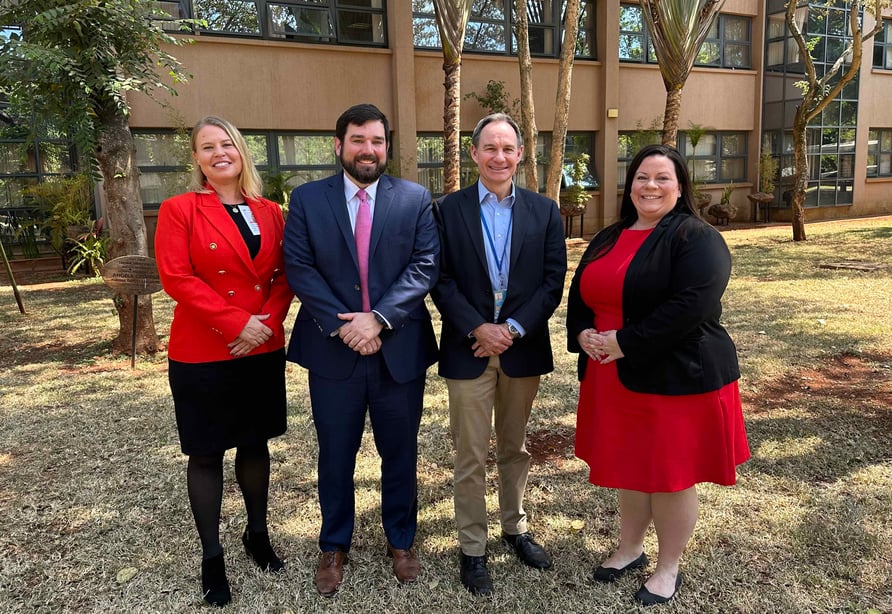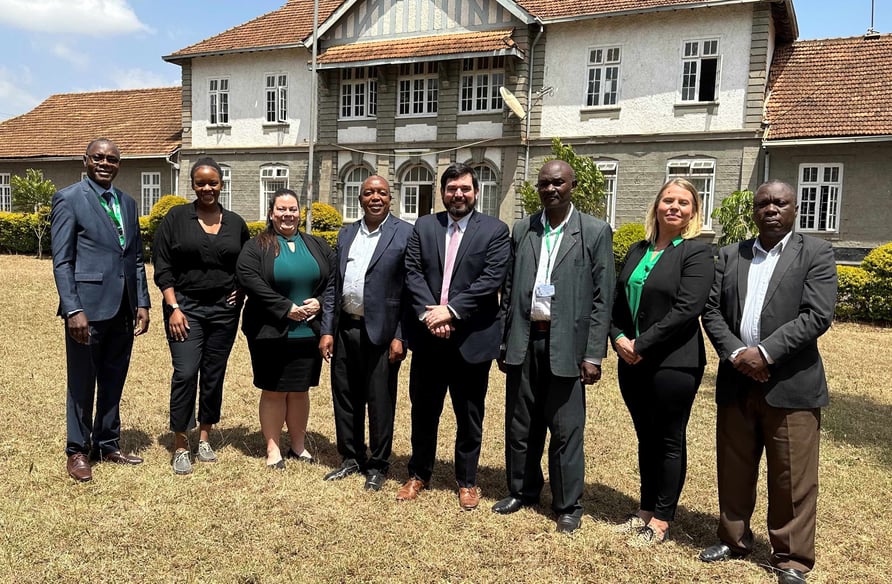HIGHLIGHTS: February 10, 2023
• December and year-end trade data
• Seeking member input on EU packaging proposals
• USDEC meets with UNEP leaders
• Ready for download: new USDEC ingredient monograph
• Feb. 16 is discount hotel rate deadline for spring Membership Meeting
• USDA Ag Outlook Forum around the corner
• Market Summary: China drives GDT gain
• Letter urges U.S. Codex leadership
• USDEC engagement leads to GI questions at Senate Ag Committee hearing
• Company news: Junlebao, Danone, Meiji, McDonald’s
Featured
U.S. sets dairy export records in 2022 despite a host of challenges
U.S. dairy suppliers set a third consecutive volume record in 2022, exporting 2.4 million MT milk solids equivalent. They also set a record for value—$9.6 billion—the first time it has ever crossed the $9-billion mark.
The year-end numbers come as no surprise—trends throughout most of 2022 were pointing toward a potential record and a couple of categories had already surpassed previous highs after only 11 months. But the numbers are impressive nonetheless, given a host of challenges to international trade.
“We’ve had three consecutive years of record U.S. dairy exports while facing some of the strongest dairy export headwinds that we’ve ever seen,” USDEC President and CEO Krysta Harden said in a press release on the year-end results. “Last year, we saw historic global inflation, slowing economic growth, lingering supply chain challenges and severely reduced Chinese demand. U.S. dairy export performance under those conditions is a testament to U.S. suppliers’ commitment to global markets and also to the value consumers in those markets have come to place on U.S. dairy products.”
What’s next?
Three straight years of record volume raises the question: Will there be a fourth?
For NFDM/SMP, global supply and inventory management will be key drivers of trade in 2023. The high prices seen in 2022 that drove buyers out of the market have been retreating, with current SMP prices falling nearly 40% compared to a year ago. With lower prices, many key importers are rebuilding stocks, but the major question for SMP demand hinges on China, where imports were extraordinarily weak in 2022. If China re-enters the market for SMP, we can expect prices – and exports – to react positively as global demand lifts.
Regarding cheese, competition from Europe is increasing as the bloc’s milk production climbs, internal demand weakens, and prices collapse. Similarly, with China’s demand for ingredients remaining weak, New Zealand has increased its focus on cheese production and exports. Thankfully, international demand appears to be holding steady, but competition will abound for U.S. cheese exporters in 2023.
Outlooks for these and other product categories are provided in the blog post, U.S. dairy exports finished record 2022 on a high note. For principal market factors influencing dairy import demand and trade in the year ahead, see Six indicators of U.S. dairy export performance in 2023.
December results snapshot
Most all major export products grew in December, with cheese up 16% (+5,035 MT), NFDM/SMP up 8% (+4,675 MT), whey products up a combined 20% (+8,200 MT) and lactose up 30% (+8,849 MT). Of the major products, only butterfat (-4%, -202 MT) and fluid milk/cream (-4%, -462 MT) were down slightly in December.
Overall, December’s data reflected a continuation of the major trends we saw throughout the year: long-term investment by the U.S. dairy industry combined with available supplies and strong demand from the key U.S. markets drove exports to record heights. To give a sample of the numbers, U.S. exports to Mexico were up 23% (MSE) in December, raising year-end volume by 9%. Similarly, Japan was up 27% in December and 22% for the year; China grew 75% in December, 11% for the year; Korea rose 4% for December, 9% for the year; and the list goes on.
For more information, go to USDEC’s Data Hub.
USDEC seeks member feedback on proposed EU packaging regulations
The EU has issued two draft regulations impacting packaging, and the MARA team is looking for member input on the potential impact so that we may submit comments on your behalf.
One proposal includes a major overhaul of the EU’s packaging regulations to align with the European Commission’s (EC) environmental goals as part of the European Green Deal. The new requirements will apply to all packaging marketed in the EU and include specific targets for recyclability and use of post-consumer waste content. Importers will be responsible for ensuring that imported packaging complies with the new requirements, and customs authorities will check packaging at entry points. The comment date has yet to be set, as the draft texts are in the process of translation into all EU member state languages. However, this is a major regulatory overhaul, so we wanted to give members ample time to review the proposal.
A second proposal updates the list of approved food contact materials. Comments are due to USDEC by March 10.
Click here for a summary of both regulations. Send feedback to Sandra Benson at sbenson@usdec.org.
USDEC proactively positions U.S. dairy sustainability story and trade with UN environment leaders
USDEC’s Sustainability and Multilateral Affairs (SAMA) team was in Nairobi, Kenya this week engaging with the United Nations Environment Program (UNEP), U.S. government representatives, key UNEP member states and regional partners. USDEC had multiple goals for the meetings: promote the critical role of U.S. dairy exports in sustainable food systems, support science-based policymaking and proactively mitigate potential UN-driven barriers to U.S. dairy exports.
USDEC’s delegation consisted of Nick Gardner, senior vice president, Sustainability and Multilateral Affairs, Kelly Sheridan, vice president, Environmental Affairs and Janice Giddens, vice president, Sustainable Nutrition. The trip was scheduled following USDEC’s successful accreditation as an official UNEP observer last year and reflects UNEP’s increasing focus on agricultural policy as part of its environmental mandate.

Left to right: USDEC’s Kelly Sheridan, vice president, Environmental Affairs; Nick Gardner, senior vice president, Sustainability and Multilateral Affairs; and Janice Giddens, vice president, Sustainable Nutrition, were in Nairobi, Kenya, this week to share U.S. dairy perspectives with the United Nations Environment Program, U.S. government officials and other leaders.
Accelerating UNEP engagement
The team’s meetings were structured to maximize impact and create a strategic launchpad for future engagements on issues where UNEP recommendations may lack data or important perspectives and could constrain U.S. dairy exports in key international markets that have a history of adopting UNEP policies. In furtherance of USDEC’s longstanding commitment to science-based policymaking, the team’s first visit was with leaders of the UNEP Science Division to discuss the opportunities for USDEC to leverage the investments of the U.S. Dairy Checkoff by contributing scientific evidence and data to support the development of UNEP positions, recommendations and global reports.
Other meetings were secured with representatives who determine how the private sector participates in the UNEP process, and the highly-influential UNEP Ecosystems Divisions. That division has a role implementing outcomes from the legally-binding global treaty on biological diversity and is the focal point for all of UNEP’s food systems recommendations.

The USDEC team met with United States Permanent Representative to UNEP Bill Lehmberg (second from right) to discuss how U.S. dairy exports can sustainably nourish consumers around the world.
A meeting with United States Permanent Representative to UNEP, Bill Lehmberg, secured a strong commitment to collaborate at UNEP on potential areas of concern for U.S. dairy exports. Lehmberg said he appreciated learning more about the critical role of U.S. dairy exports and trade play in delivering more sustainable food systems. A similarly positive discussion was held with Ryan Scott, USDA’s Regional Agriculture Counselor, who said he is eager to work with USDEC despite the protectionist Kenyan policies that plague efforts to grow U.S. dairy exports into the country.
Over the course of the week, the team also met with several other member state representatives, providing critical insights into potential issues of concern and opportunities to promote dairy trade in the lead up to the 6th session of the UN Environmental Environment Assembly (UNEA-6), which will take place in early 2024.
Enhanced regional partnerships
The team rounded out its agenda visiting with regional partners and allies to strengthen collaboration and support shared priorities. These included:
- Busara Center for Behavioral Economics, where USDEC has joined with the Global Dairy Platform (GDP) and the UN Food and Agriculture Organization (FAO) to support research on social, nutritional and educational outcomes associated school milk programs.
- The International Livestock Research Institute (ILRI), a key USDEC ally in promoting the critical role of dairy and other animal-sourced foods in food systems in global forums like COP.
- Allan Azegele, deputy director of veterinary services, Kenya Ministry of Agriculture, Livestock, Fisheries and Cooperatives, who currently serves as the vice-chair of Codex Alimentarius.
To learn more about USDEC’s UNEP priorities or how you can get involved, please contact Kelly Sheridan (ksheridan@usdec.org).

USDEC was privileged to meet with Codex Vice-chair Allan Azegele (far left) along with his colleagues in Kenya to discuss Codex priorities for U.S. dairy and topics that could impact dairy market access.
USDEC updates ice cream/frozen dessert ingredient monograph
An updated version of USDEC’s ice cream monograph is now available at ThinkUSADairy.org. The report is one in a series of application monographs USDEC has published over the years aimed at global customers of U.S. dairy ingredients.
The series speaks to USDEC’s efforts to help food and beverage formulators seize new innovation opportunities by capitalizing on the nutritional and functional benefits of U.S. dairy ingredients while also addressing technical hurdles. It is part of USDEC’s broader efforts to help global end-users find success with U.S. dairy ingredients and cement the reputation of the U.S. industry as knowledgeable, helpful partners in that success.
The new ice cream/frozen dessert report:
- Provides formulation tips and technical insights.
- Educates end-users on how and why to incorporate milk and whey-derived ingredients into local-friendly applications.
- Delivers sample formulations showcasing dairy ingredients.
We encourage members to download and share the new ice cream monograph as well as other USDEC reports in the series. Click on the links below to access the reports to share with customers or share the links with customers so they can download the reports themselves.
Events
Don’t miss the discount hotel rate deadline for USDEC’s spring Membership Meeting
The deadline to reserve a room at a discounted rate for the USDEC spring Membership Meeting is next week, Thursday, Feb. 16. The meeting runs March 27-29 at the Willard Intercontinental Hotel in Washington, D.C. Please click here and use the group code DM3 to reserve a room.
The preliminary agenda for the USDEC spring Membership Meeting is now ready for download. Check out the schedule to see the initial list of confirmed and invited speakers and then register for the meeting by clicking here.
Among the highlights:
- Dusty Johnson (R-S.D.) will provide a congressional perspective on agriculture, trade and supply chain policy.
- A panel of international trade experts, including Michelangelo Margherita, Head of Trade Section, European Commission, and Lloyd Day, deputy director general, Inter-American Institute for Cooperation, will discuss how to strengthen global connections across borders.
- William Loux, USDEC vice president, Global Economic Affairs; Stephen Cain, USDEC director, Economic Research and Analysis; and Peter Vitaliano, NMPF vice president, Economic Policy and Market Research, will provide their joint take on U.S. and global dairy markets.
This will be the only USDEC Membership Meeting this year, and there will be no virtual attendance option (although most sessions will be recorded and made available online sometime after the event).
Supply chain challenges and other issues affecting trade to be discussed at USDA’s Agricultural Outlook Forum
The Agricultural Outlook Forum is USDA’s largest annual meeting, attracting as many as 2,000 attendees from the U.S. and abroad. The forum highlights key issues and topics within the agricultural community, offering a platform for conversation among producers, processors, policymakers, government officials, and non-governmental organizations, both foreign and domestic.
The Forum will be held Feb. 23-24 in Arlington, Virginia. Stakeholders may attend either in person or virtually. Registration is required. Click here to see the agenda and register.
Market Summary
GDT prices rise on WMP, butterfat
The Global Dairy Trade (GDT) Price Index posted its biggest increase since last September, rising 3.2% at the Feb. 7, 2023 auction. A much more active China help drive the price gains. Chinese buyers won two-thirds of WMP, driving up the average winning price by 3.8% to US$3,329/MT. China also led all purchasers for butter (+6.6% to US$4,745/MT) and AMF (+4.8% to US$5,586/MT).
Prices were up solidly for all three products across all contract periods. It was a positive sign after sizable declines in five of the previous eight auctions, overall bearish market sentiment and ongoing questions about Chinese demand. While it’s too soon to say the auction is a sign of a turnaround, it comes as China appears to be pulling out of its COVID surge and among more upbeat reports of economic recovery and expectations of improved consumption.
The SMP price largely held steady at US$2,829/MT, a better-than-expected result given increased supply out of Europe and recent price trends in the EU and U.S.
Trade Policy
Coalition letter calls for continued U.S. government leadership at Codex
The Food Industry Codex Coalition (FICC) sent a letter this week to Alexis Taylor, USDA Under Secretary for Trade and Foreign Agricultural Affairs, urging continued U.S. leadership and engagement with the Codex Alimentarius Commission. The FICC is a group of more than 70 U.S. food and beverage companies and associations, including USDEC and NMPF, with a keen interest in Codex activities and the science-based level playing field it creates through the development of international standards.
The letter states Codex’s commitment to science-based decision making, risk assessment, transparency and participation by all relevant stakeholders is under threat. Certain international stakeholders are increasingly challenging the organization’s commitments as they seek to advance their national trade agendas by pushing Codex beyond its scope or mandate and undermining other foundational Codex values.
The FICC thanked USDA for its recent Codex work and successes but added that “United States leadership and resolute engagement … is needed now more than ever.”
“The many important and unresolved issues remaining before Codex make this a critical time for the United States to maintain and increase its commitment to the institution,” the letter concludes.
USDEC prepares senators ahead of first agricultural trade hearing of the 118th Congress
Ahead of a Feb. 1 meeting on the next Farm Bill, USDEC’s Trade Policy team worked to prepare members of the U.S. Senate Committee on Agriculture, Nutrition and Forestry on some of the important issues affecting U.S. dairy exports.
That, in turn, was reflected in some of the comments made by senators about the importance of free trade agreements, whether enforcing existing ones or developing new ones.
“The success of our agricultural economy requires continued investments in markets and opportunities for farmers,” said Sen. Debbie Stabenow (D-MI).
Members of the committee were provided background on some of the trade barriers that U.S. dairy suppliers face, such as the EU’s geographical indications (GI) policy and its impact on common cheese names and U.S. dairy exports. Senators Amy Klobuchar (D-MN) and Tina Smith (D-MN) specifically raised the issue of the EU’s aggressive efforts to monopolize cheese names though GI overreach.
“I have yet to see feta on a map,” said Under Secretary of Trade and Foreign Agricultural Affairs Alexis Taylor. “We are engaging to make sure that intellectual property rights are being respected, but that these generic names that we use do not become a barrier for our trade.”
Company News
Junlebao invests in milk and cheese
China’s Junlebao plans to spend $442 million to build a dairy processing facility and three dairy farms in the Yangtze River Delta region. The project will support the government’s school milk program. The company expects to begin construction in March. Separately, Junlebao purchased a 10% stake in cheese manufacturer Shanghai Laoshen Health Technology Development Co. and plans to build a cheese factory this year, with an eye toward becoming one of China’s top cheese manufacturers over the next five years. (USDEC China office)
Company news briefs
On Jan. 31, Japan’s Meiji began production at the first of three new facilities set to open in China this year. The fluid milk/yogurt processing plant is in Tianjin, China (See Global Dairy eBrief, 10/21/22). … McDonald’s plans to open 900 new units in China in 2023. It has increased store openings for the past two years: 480 in 2020, 660 in 2021 and 700 in 2022. It currently operates more than 5,000 stores in China. … Malaysia-based investment group Wellspire Holdings is looking to import dairy beverages, including yogurt and UHT milk, as part of an effort to expand business in Thailand. … Danone opened a new research and innovation center at its Paris-Saclay campus in France. The facility, with a staff of more than 550, pilot plants and labs, will focus on “fresh dairy and plant-based products” and mineral water. (USDEC China office; USDEC Southeast Asia office; Company reports)
In Case You Missed It...
U.S. Dairy Exporter Blog
Market analysis, research and news subscribe hereUSDEC Twitter feed
Follow us here.